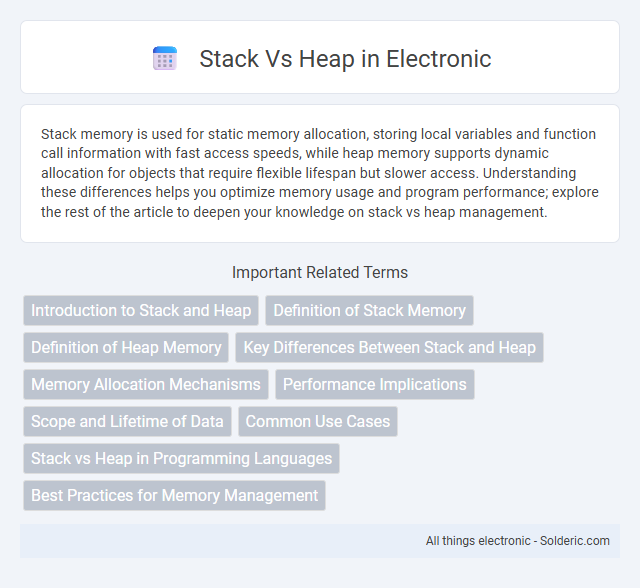Stack memory is used for static memory allocation, storing local variables and function call information with fast access speeds, while heap memory supports dynamic allocation for objects that require flexible lifespan but slower access. Understanding these differences helps you optimize memory usage and program performance; explore the rest of the article to deepen your knowledge on stack vs heap management.
Comparison Table
| Aspect | Stack | Heap |
|---|---|---|
| Memory Allocation | Automatic (LIFO) | Dynamic (manual or GC) |
| Size | Limited, smaller | Large, expandable |
| Access Speed | Faster | Slower |
| Lifetime | Short-lived (function scope) | Long-lived (program scope) |
| Management | Compiler-managed | Programmer/Runtime-managed |
| Fragmentation | No fragmentation | Potential fragmentation |
| Usage | Local variables, function calls | Dynamic objects, large data |
Introduction to Stack and Heap
Stack and heap are fundamental memory areas used for dynamic and static memory allocation in programming. The stack stores function call frames, local variables, and control flow data with a last-in, first-out (LIFO) structure, offering fast access and automatic memory management. The heap manages dynamic memory allocation for objects and data that require flexible lifetimes, using pointers and manual allocation/deallocation handled by the programmer or garbage collector.
Definition of Stack Memory
Stack memory is a region of a computer's memory that stores temporary variables created by each function, operating in a Last In, First Out (LIFO) manner. It manages function calls, local variables, and control flow information, allowing for efficient memory allocation and deallocation. Stack memory is limited in size but provides fast access and automatic cleanup when functions exit.
Definition of Heap Memory
Heap memory is a region of a computer's memory used for dynamic allocation, enabling programs to request and release memory at runtime. Unlike stack memory, heap storage is not automatically managed, requiring explicit allocation and deallocation through functions like malloc() and free() in C or new and delete in C++. Heap memory supports variable lifetimes, allowing objects to persist beyond the scope of the function that created them, which is essential for managing complex data structures such as linked lists and trees.
Key Differences Between Stack and Heap
The key differences between stack and heap memory lie in their allocation, management, and lifespan. Stack memory is automatically allocated and managed with a Last-In-First-Out (LIFO) structure, making it faster but limited in size, while heap memory allows dynamic allocation, offering flexibility at the cost of slower access and manual management. Understanding these differences helps you optimize performance and memory usage in your applications.
Memory Allocation Mechanisms
Stack memory allocation operates with a last-in, first-out (LIFO) structure that allows fast and efficient management of small, short-lived data such as function parameters and local variables. Heap memory allocation handles dynamic memory requests, enabling the storage of larger data objects and unpredictable lifetimes, but requires explicit management through allocation and deallocation functions like malloc and free in C or new and delete in C++. Your program benefits from combining both mechanisms to optimize speed and flexibility in memory usage.
Performance Implications
Stack memory allocation offers faster performance due to its contiguous memory structure and automatic management via LIFO order, minimizing overhead and enabling quicker access times. Heap allocation incurs higher latency caused by dynamic memory management, fragmentation, and the need for garbage collection or manual deallocation, which can lead to unpredictable performance. Optimizing application performance requires leveraging stack allocation for short-lived, fixed-size data and reserving heap allocation for large, complex, or variable-sized objects where flexibility outweighs speed.
Scope and Lifetime of Data
The stack stores data with a well-defined scope and lifetime, typically limited to the duration of function calls, making it suitable for primitive variables and function arguments. The heap supports dynamic memory allocation, allowing data to persist beyond the scope of a single function until explicitly deallocated, ideal for objects requiring flexible lifetimes. Understanding these differences helps optimize your program's memory management and prevents issues like memory leaks or stack overflow.
Common Use Cases
Stack is commonly used for storing local variables, function parameters, and control flow information, offering fast access and automatic memory management ideal for short-lived data. Heap is preferred for dynamic memory allocation, managing objects whose size or lifespan is not known at compile time, such as large data structures, dynamically created objects, and resources shared across functions or threads. In performance-critical applications, stack allocation is favored for its speed, while heap allocation provides flexibility and scalability in complex software systems.
Stack vs Heap in Programming Languages
Stack and heap are fundamental memory structures used in programming languages to manage data differently. The stack stores local variables and function call information in a last-in, first-out manner, enabling fast allocation and deallocation, whereas the heap handles dynamic memory allocation for objects whose size or lifetime isn't known at compile time. Understanding how your programming language uses stack versus heap impacts performance, memory management, and debugging efficiency.
Best Practices for Memory Management
Effective memory management requires allocating short-lived variables on the stack for faster access and automatic deallocation, while dynamically allocating larger or persistent data on the heap to avoid stack overflow. You should always pair heap allocations with proper deallocation using techniques like smart pointers in C++ or garbage collection in managed languages to prevent memory leaks. Monitoring and profiling memory usage helps optimize performance and maintain application stability by balancing stack and heap utilization.
Stack vs Heap Infographic

 solderic.com
solderic.com